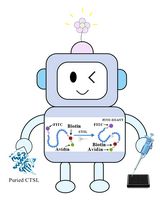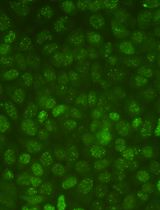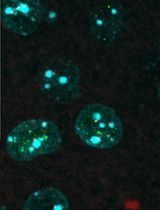- EN - English
- CN - 中文
In vitro Assay to Measure DNA Polymerase β Nucleotide Insertion Coupled with the DNA Ligation Reaction during Base Excision Repair
体外实验检测在碱基去除修复中聚合酶β联合DNA连接反应介导的核苷酸插入
发布: 2017年06月20日第7卷第12期 DOI: 10.21769/BioProtoc.2341 浏览次数: 7679
评审: Gal HaimovichOmar AkilAnonymous reviewer(s)
Abstract
We previously reported that oxidized nucleotide insertion by DNA polymerase β (pol β) can confound the DNA ligation step during base excision repair (BER) (Çağlayan et al., 2017). Here, we describe a method to investigate pol β nucleotide insertion coupled with DNA ligation, in the same reaction mixture including dGTP or 8-oxo-dGTP, pol β and DNA ligase I. This in vitro assay enables us to measure the products for correct vs. oxidized nucleotide insertion, DNA ligation, and ligation failure, i.e., abortive ligation products, as a function of reaction time. This protocol complements our previous publication and describes an efficient way to analyze activities of BER enzymes and the functional interaction between pol β and DNA ligase I in vitro.
Keywords: DNA base excision repair (DNA碱基切除修复)Background
This protocol is to observe the last two steps of the BER pathway: nucleotide insertion by pol β and DNA ligation by ligase I. Using this protocol, one measures both reactions as a function of time of incubation in the same reaction mixture in vitro. The original entity was to analyze BER enzymes pol β and DNA ligase I on the single-nucleotide gapped DNA substrate that mimics a BER intermediate. These BER enzymes bind to and function on this BER intermediate. The DNA substrate used in this protocol includes a fluorescent label at both 5’- and 3’-ends that enables us to observe single-nucleotide insertion and DNA ligation of the DNA substrate. The pol β nucleotide insertion coupled with DNA ligation mimics the hand off or channeling of the nicked DNA intermediate from nucleotide insertion step to following ligation step during BER pathway. Using this protocol, one is also able to measure ligation failure, or abortive ligation, after pol β oxidized nucleotide (8-oxo-dGTP) insertion. This is achieved by quantification of the addition of an adenylate (AMP) group at 5’-end of the BER intermediate. This protocol can also be used to measure nucleotide insertion coupled with ligation using other DNA polymerases and DNA ligases.
Materials and Reagents
- Eppendorf tubes (1.5 ml)
- Pipette tips (10 μl, 100 μl, 1,000 μl)
- Deoxyguanosine triphosphate (dGTP) (New England Biolabs, catalog number: N0447S )
- 8-oxo-2’-deoxyguanosine-5’-Triphosphate (8-oxo-dGTP) (Jena Bioscience, catalog number: NU-1117L )
- DNA substrate: The DNA substrate includes a fluorescent tag at both the 5’- and 3’-ends of one of the gap-containing strand in the double-stranded DNA with a single nucleotide gap opposite template base Cytosine (Çağlayan et al., 2017)
Note: The sequence information for the DNA substrate is presented in the Notes section of the protocol. - Tris-HCl (pH 7.5)
- Potassium chloride (KCl) (Sigma-Aldrich, catalog number: P9333 )
- Magnesium chloride (MgCl2) (Sigma-Aldrich, catalog number: M8266 )
- Adenosine 5’-Triphosphate (ATP) (New England Biolabs, catalog number: P0756S )
- Dithiothreitol (DTT) (Sigma-Aldrich, catalog number: D0632 )
- Bovine serum albumin (BSA) (New England Biolabs, catalog number: B9000S )
- Glycerol (Sigma-Aldrich, catalog number: G9012 )
- HEPES (pH 7.5)
- Sodium chloride (NaCl)
- EDTA (Sigma-Aldrich, catalog number: 93283 )
- Purified enzymes: Recombinant human DNA polymerase β and DNA ligase I (see Recipes and Figure 2)
- Formamide (Sigma-Aldrich, catalog number: F9037 )
- Bromophenol blue (Sigma-Aldrich, catalog number: B0126 )
- Xylene cyanol (Sigma-Aldrich, catalog number: X4126 )
- Trizma-base (Sigma-Aldrich, catalog number: T4661 )
- Boric acid (Promega, catalog number: H5003 )
- Urea (National Diagnostic, catalog number: EC-605 )
- Ammonium persulfate (APS) (Sigma-Aldrich, catalog number: A3678-25G )
- Tetramethylethylenediamine (TEMED) (Sigma-Aldrich, catalog number: T9281-25ML )
- Sterile water
- AccuGel (40%) 19:1 Acrylamide to Bisacrylamide Stabilized Solution (National Diagnostic, catalog number: EC-850 )
- Full-range rainbow protein ladder (AmershamTM ECLTM RainbowTM Marker) (GE Healthcare, catalog number: RPN800E )
- 1x reaction buffer (see Recipes)
- 1x protein storage and dilution buffer (see Recipes)
- Enzyme mixture (see Recipes)
- Gel-loading dye (see Recipes)
- 10x TBE solution (see Recipes)
- Denaturing PAGE solution (15%) (see Recipes)
- EDTA buffer (pH 8.0) (see Recipes)
Equipment
- Pipettes (P2, P10, P20, P100, P200)
- Table-top heat block (Digital Dry Block Heater, VWR)
- Polyacrylamide gel electrophoresis (PAGE) apparatus (Biometra, model: Model S2 )
- Typhoon Phosphor Imager (GE Healthcare, model: Typhoon FLA 9500 )
Procedure
文章信息
版权信息
© 2017 The Authors; exclusive licensee Bio-protocol LLC.
如何引用
Çağlayan, M. and Wilson, S. H. (2017). In vitro Assay to Measure DNA Polymerase β Nucleotide Insertion Coupled with the DNA Ligation Reaction during Base Excision Repair. Bio-protocol 7(12): e2341. DOI: 10.21769/BioProtoc.2341.
分类
分子生物学 > DNA > DNA 损伤和修复
生物化学 > 蛋白质 > 活性
您对这篇实验方法有问题吗?
在此处发布您的问题,我们将邀请本文作者来回答。同时,我们会将您的问题发布到Bio-protocol Exchange,以便寻求社区成员的帮助。
Share
Bluesky
X
Copy link














